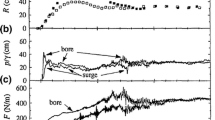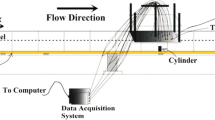Abstract
In this paper, a multiphase three-dimensional numerical reproduction of a large-scale laboratory experiment of tsunami-like bore interaction with a surface-piercing circular column is presented. The numerical simulation is conducted using OpenFOAM. A dam-break mechanism is implemented in order to generate tsunami-like bores. The numerical model is validated using the results of experiments performed at the Canadian Hydraulics Center of the National Research Council in Ottawa, Canada. Unsteady Reynolds-Averaged Navier–Stokes equations are used in order to treat the turbulence effects. The Shear Stress Transport k–ω turbulence model showed a high level of accuracy in replicating the bore–structure interactions. A scaled-up domain is used to investigate the influence of bed condition in terms of various downstream depths and roughnesses. Finally, a broad investigation on bore propagation characteristics is performed. The stream-wise forces exerted on the structural column as well as the bore velocity are compared and analyzed for smooth, rough, dry and wet beds with varying depths.



















Similar content being viewed by others
References
Árnason H (2005) Interactions between an incident bore and a free-standing coastal structure. Doctoral dissertation. Univ. of Washington, Seattle
Árnason H, Petroff C, Yeh H (2009) Tsunami bore impingement onto a vertical column. J Disaster Res 4(6):391–403
Berberovic E, van Hinsberg NP, Jakirlic S, Roisman IV, Tropea C (2009) Drop impact onto a liquid layer of finite thickness: dynamics of the cavity evolution. Phys Rev E 79:036306
Chanson H (2006) Tsunami surges on dry coastal plains: application of dam break wave equations. Coast Eng J 48(4):355–370
Chanson H (2009) Application of the method of characteristics to the dam break problem. J Hydraul Res 47(1):41–49
Crespo AJC, Gómez-Gesteira M, Dalrymple RA (2008) Modeling dam break behavior over a wet bed by a SPH technique. J Waterw Port Coast Ocean Eng 134(6):313–320
del Jesus M, Lara JL, Losada IJ (2012) Three-dimensional interaction of waves and porous coastal structures. Part I: numerical model formulation. Coast Eng 64:57–72
Douglas S, Nistor I (2015) On the effect of bed condition on the development of tsunami-induced loading on structures using OpenFOAM. Nat Hazards 76(2):1335–1356
Gómez-Gesteira M, Dalrymple RA (2004) Using a three-dimensional smoothed particle hydrodynamic method for wave impact on a tall structure. J Waterw Port Coast Ocean Eng 130(2):63–69
Higuera P, Lara JL, Losada IJ (2013) Realistic wave generation and active wave absorption for Navier–Stokes models: application to OpenFOAM. Coast Eng 71:102–118
Janosi IM, Jan D, Szabo KG, Tel T (2004) Turbulent drag reduction in dam-break flows. Exp Fluids 37:219–229
Kawamura T, Mayer S, Garapon A, Sorensen L (2002) Large Eddy simulation of a flow past a free surface piercing circular cylinder. ASME J Fluids Eng 124:91–101
Launder BE, Spalding DB (1974) The numerical computation of turbulent flows. Comput Methods Appl Mech Eng 3(2):269–289
Leal JGAB, Ferreira RML, Cardoso AH (2006) Dam-break wave-front celerity. J Hydraul Eng 132(1):69–76
Menter FR (1994) Two-equation eddy-viscosity turbulence models for engineering applications. AIAA J 32(8):1598–1605
Nouri Y, Nistor I, Palermo D (2010) Experimental investigation of tsunami impact on free standing structures. Coast Eng J JSCE 52(1):43–70
Ramsden JD (1993) Tsunamis: forces on a vertical wall caused by long waves, bores, and surges on a dry bed. W. M. Keck laboratory of hydraulics and water resources report, 54. California Institute of Technology, Pasadena, CA
Ramsden JD (1996) Forces on a vertical wall due to long waves, bores, and dry bed surges. J Waterw Port Coasts Ocean Eng 122(3):134–141
Rusche H (2002) Computational fluid dynamics of dispersed two-phase flows at high phase fractions. Ph.D. thesis, Imperial College, London
Sadeque MAF, Rajaratnam N, Loewen MR (2008) Flow around cylinders in open channels. ASCE J Eng Mech 134(1):60–71
St-Germain P, Nistor I, Townsend R (2012) Numerical modeling of the impact with structures of tsunami bores propagating on dry and beds using the SPH method. Int J Protect Struct 3(2):221–255
St-Germain P, Nistor I, Townsend R, Shibayama T (2014) Smoothed particle hydrodynamics numerical modeling of structures impacted by tsunami bores. J Waterw Port Coast Ocean Eng 140(1):66–81
Wei Z, Dalrymple RA, Hérault A, Bilotta G, Rustico E, Yeh H (2015) SPH modeling of dynamic impact of tsunami bore on bridge piers. J Coast Eng 104:26–42
Weller HG (2008) A new approach to VOF-based interface capturing methods for incompressible and compressible flow. Technical report TR/HGW/04, OpenCFD Ltd.
Wilcox DC (1988) Re-assessment of the scale-determining equation for advanced turbulence models. AIAA J 26(11):1299–1310
Yeh H, Sato S, Tajima Y (2013) The 11 March 2011 East Japan earthquake and tsunami: tsunami effects on coastal infrastructure and buildings. Pure appl Geophys 170:1019–1031
Yu G, Avital EJ, Williams JJR (2008) Large Eddy simulation of flow past free surface piercing circular cylinders. ASME J Fluids Eng Trans 130(10):41–49
Author information
Authors and Affiliations
Corresponding author
Additional information
Publisher's Note
Springer Nature remains neutral with regard to jurisdictional claims in published maps and institutional affiliations.
Rights and permissions
About this article
Cite this article
Asadollahi, N., Nistor, I. & Mohammadian, A. Numerical investigation of tsunami bore effects on structures, part II: effects of bed condition on loading onto circular structures. Nat Hazards 96, 331–351 (2019). https://doi.org/10.1007/s11069-018-3544-0
Received:
Accepted:
Published:
Issue Date:
DOI: https://doi.org/10.1007/s11069-018-3544-0




